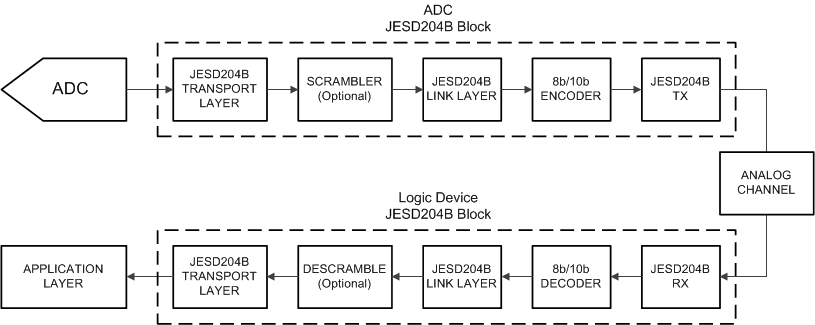SLVSDR2B November 2018 – March 2021 ADC12DJ3200QML-SP
PRODUCTION DATA
- 1 Features
- 2 Applications
- 3 Description
- 4 Revision History
- 5 Pin Configuration and Functions
-
6 Specifications
- 6.1 Absolute Maximum Ratings
- 6.2 ESD Ratings
- 6.3 Recommended Operating Conditions
- 6.4 Thermal Information
- 6.5 Electrical Characteristics: DC Specifications
- 6.6 Electrical Characteristics: Power Consumption
- 6.7 Electrical Characteristics: AC Specifications (Dual-Channel Mode)
- 6.8 Electrical Characteristics: AC Specifications (Single-Channel Mode)
- 6.9 Timing Requirements
- 6.10 Switching Characteristics
- 6.11 Timing Diagrams
- 6.12 Typical Characteristics
-
7 Detailed Description
- 7.1 Overview
- 7.2 Functional Block Diagram
- 7.3
Feature Description
- 7.3.1 Analog Inputs
- 7.3.2 ADC Core
- 7.3.3 Timestamp
- 7.3.4 Clocking
- 7.3.5 Digital Down Converters (Dual-Channel Mode Only)
- 7.3.6 JESD204B Interface
- 7.3.7 Alarm Monitoring
- 7.3.8 Temperature Monitoring Diode
- 7.3.9 Analog Reference Voltage
- 7.4
Device Functional Modes
- 7.4.1 Dual-Channel Mode
- 7.4.2 Single-Channel Mode (DES Mode)
- 7.4.3 JESD204B Modes
- 7.4.4 Power-Down Modes
- 7.4.5 Test Modes
- 7.4.6 Calibration Modes and Trimming
- 7.4.7 Offset Calibration
- 7.4.8 Trimming
- 7.4.9 Offset Filtering
- 7.5 Programming
- 7.6 Register Maps
- 8 Application Information Disclaimer
- 9 Layout
- 10Device and Documentation Support
7.3.6 JESD204B Interface
The ADC12DJ3200QML-SP uses the JESD204B high-speed serial interface for data converters to transfer data from the ADC to the receiving logic device. The ADC12DJ3200QML-SP serialized lanes are capable of operating up to 12.8 Gbps, slightly above the JESD204B maximum lane rate. A maximum of 16 lanes can be used to allow lower lane rates for interfacing with speed-limited logic devices. Figure 7-19 shows a simplified block diagram of the JESD204B interface protocol.
 Figure 7-19 Simplified JESD204B Interface Diagram
Figure 7-19 Simplified JESD204B Interface DiagramThe various signals used in the JESD204B interface and the associated ADC12DJ3200QML-SP pin names are summarized briefly in Table 7-15 for reference.
Table 7-15 Summary of JESD204B Signals
| SIGNAL NAME | ADC12DJ3200QML-SP PIN NAMES | DESCRIPTION |
|---|---|---|
| Data | DA0+...DA7+, DA0–...DA7–, DB0+...DB7+, DB0–...DB7– | High-speed serialized data after 8b, 10b encoding |
| SYNC | SYNCSE, TMSTP+, TMSTP– | Link initialization signal (handshake), toggles low to start code group synchronization (CGS) process |
| Device clock | CLK+, CLK– | ADC sampling clock, also used for clocking digital logic and output serializers |
| SYSREF | SYSREF+, SYSREF– | System timing reference used to deterministically reset the internal local multiframe counters in each JESD204B device |